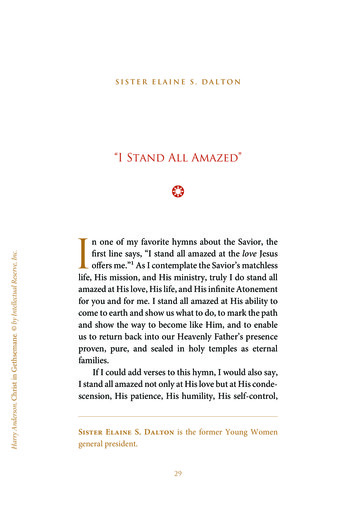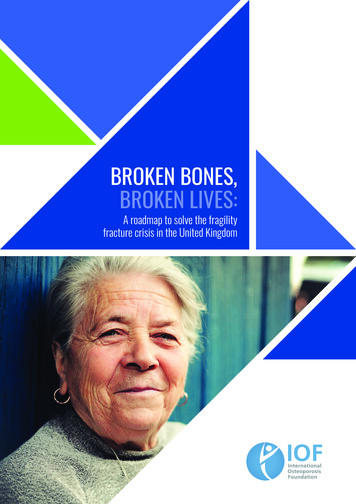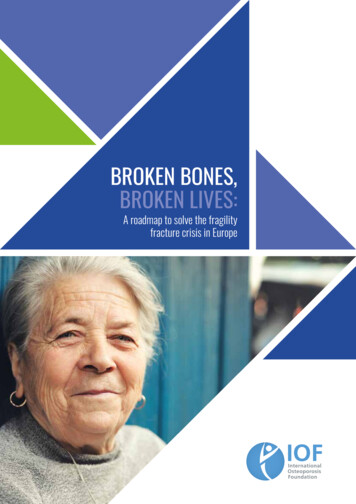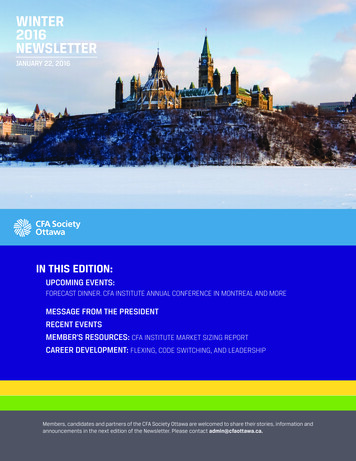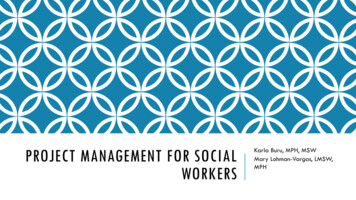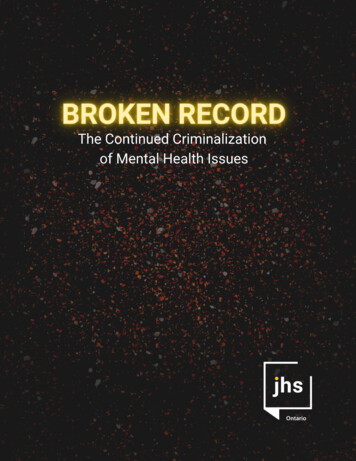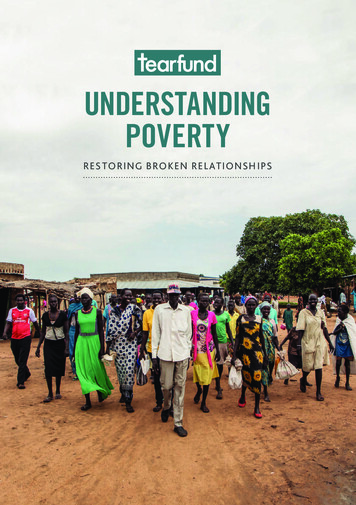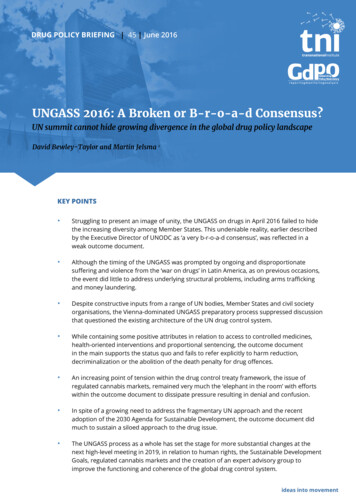
Transcription
Drug Policy Briefing 45 June 2016UNGASS 2016: A Broken or B-r-o-a-d Consensus?UN summit cannot hide growing divergence in the global drug policy landscapeDavid Bewley-Taylor and Martin Jelsma 1Key Points Struggling to present an image of unity, the UNGASS on drugs in April 2016 failed to hidethe increasing diversity among Member States. This undeniable reality, earlier describedby the Executive Director of UNODC as ‘a very b-r-o-a-d consensus’, was reflected in aweak outcome document. Although the timing of the UNGASS was prompted by ongoing and disproportionatesuffering and violence from the ‘war on drugs’ in Latin America, as on previous occasions,the event did little to address underlying structural problems, including arms traffickingand money laundering. Despite constructive inputs from a range of UN bodies, Member States and civil societyorganisations, the Vienna-dominated UNGASS preparatory process suppressed discussionthat questioned the existing architecture of the UN drug control system. While containing some positive attributes in relation to access to controlled medicines,health-oriented interventions and proportional sentencing, the outcome documentin the main supports the status quo and fails to refer explicitly to harm reduction,decriminalization or the abolition of the death penalty for drug offences. An increasing point of tension within the drug control treaty framework, the issue ofregulated cannabis markets, remained very much the ‘elephant in the room’ with effortswithin the outcome document to dissipate pressure resulting in denial and confusion. In spite of a growing need to address the fragmentary UN approach and the recentadoption of the 2030 Agenda for Sustainable Development, the outcome document didmuch to sustain a siloed approach to the drug issue. The UNGASS process as a whole has set the stage for more substantial changes at thenext high-level meeting in 2019, in relation to human rights, the Sustainable DevelopmentGoals, regulated cannabis markets and the creation of an expert advisory group toimprove the functioning and coherence of the global drug control system.ideas into movement
The 30th Special Session of the General Assembly (UNGASS) took place inNew York from 19 to 21 April. It was the third special session in UN historydevoted to the drugs issue. During the previous drugs UNGASS in 1998, MrUdovenko, the Ukrainian President of the General Assembly at the time,addressed in his closing remarks a “growing convergence of views” and a“spirit of togetherness”. The tough negotiations over the UNGASS outcomedocument this year, on the other hand, were characterised by growingdivergence and head-on collision on some issues.2 A fragile consensus wasreached on a final draft at the Commission on Narcotics Drugs (CND orCommission) in March in Vienna. Fears were so prevalent that it could stillbreak apart in the course of the three-day meeting that the adoption ofthe outcome document, scheduled to take place at the closing session, wasmoved forward on the agenda immediately after the opening ceremony onthe first day. When a journalist asked Mr Fedotov, the Executive Director ofthe United Nations Office on Drugs and Crime (UNODC), how the UN couldpretend there is consensus on how to tackle what has become known simplyas the ‘world drug problem’ when some countries are legalising cannabiswhile in others people are executed for trafficking it, he answered with a wrysmile: “it’s a very b-r-o-a-d consensus”.3Back in 1998, Udovenko had warned that “the drug problem cannot bewished away by good intentions and the international community mustbe prepared for a long and gruelling fight”. A long and gruelling waron drugs indeed has been fought since, with many thousands of drugtraffickers executed, many millions of drug users, small traders and farmersincarcerated, and millions of hectares of coca, opium poppy and cannabisfields sprayed with chemicals or otherwise forcibly eradicated. But it has notbrought the world closer to the promised land “free of drug abuse” as the2016 UNGASS outcome document reconfirms as the global target for 2019,when the next high level UN meeting on drugs will take place. The currentDanish President of the General Assembly (GA), Mogens Lykketoft, concludedin the closing session: “More than ever before, the global consensusrecognizes that the solution to this problem lies in a more humane, publichealth oriented, human rights compliant, evidence-based approach thataddresses this issue in all its complexity.” Affected people and communities,he said, “need interventions that have proven to work and perhaps asimportantly: they need honesty about those that have failed.”4Long-standing unresolved issuesDrug war-related violence spiralling out of control led Mexico, Colombiaand Guatemala to call for this 2016 UNGASS to “conduct an in-depth reviewanalyzing all available options, including regulatory or market measures, inorder to establish a new paradigm that would impede the flow of resourcesto organized crime groups”.5 The original call for the first UNGASS ondrugs which took place in 1990 also came from Colombia, shortly after the2 UNGASS 2016: A Broken or B-r-o-a-d Consensus?transnationalinstitute
assassination in August 1989 of leading Presidential candidate Luis CarlosGalán, ordered by Pablo Escobar. A month later Colombian President VirgilioBarco travelled to the United Nations to give a “J’accuse” speech about thedouble standards of the rich countries of the North. “Every tactic and everyweapon in the war on drugs pales into insignificance when compared tothe need to reduce demand”, he told the General Assembly, because “theonly law that the drug traffickers do not break is the law of supply anddemand”.6 He also complained about the lack of political will to introduceinternational arms controls: “Last year Colombia presented a draft resolutioncalling for restrictions on arms sales, but unfortunately consensus couldnot be found at the United Nations . I call on all the nations of the worldto stop this madness and stop it now.” And referring to money laundering,he said: “Somehow our sense of justice is warped when a poor farmerwho feeds his family by growing coca is seen as a greater villain than thewealthy international banker who illegally transfers millions of dollars ofdrug money”. While Colombia needed alternative development assistance,he underscored the importance of establishing fair prices in internationaltrade. Referring to that year’s collapse of the international coffee market: “Wecannot afford to talk idealistically of crop substitution in the case of the cocaleaf while sabotaging Colombian farmers’ main cash crop and the country’slargest export”.7A quarter of a century later those long-standing Latin American demandshave still not been addressed adequately. In fact, Mexican PresidentCalderón, at the GA in September 2012, in very similar terms, demanded thatthe developed nations assume more responsibility: “If they cannot or are notwilling to reduce drug consumption, at least they should stop the exorbitantflow of resources funding criminals. And if that is not possible, perhaps it’stime to recognize the need to explore other alternatives, including marketalternatives, to resolve this problem that has turned Latin America intothe most violent region of the world.”8 While a globally administered andenforced system of export certification and import authorization for drugsfor medical and scientific purposes has been in place since 1925, the firstarms trade treaty aimed at establishing a similar system to prevent thediversion of arms to the illicit market, only came into effect in December2014.9 And it is still waiting ratification by the US and the signature of someother major players like China and the Russian Federation. The HSBCscandal in 2012 about hundreds of millions of dollars laundered for Mexicandrug ‘cartels’ led to not one single criminal conviction of a bank official,convincingly showcasing that anti-money-laundering measures, in terms ofloopholes, look like a Swiss cheese. Families of victims murdered in Mexicofiled a lawsuit in February 2016 charging that the bank had operated in a“culture of recklessness and corruption”.10 The Panama Papers also provideample evidence that without transparency regarding the individuals orcompanies hiding behind and profiting from anonymous shell companies,control measures simply cannot be effective, an issue the 2016 UNGASS wasagain not willing to address.113 UNGASS 2016: A Broken or B-r-o-a-d Consensus?transnationalinstitute
The Vienna chokeholdAfter long negotiations in the CND on the modalities for the UNGASS, inDecember 2014 the decision was made that the Commission “as the centralpolicymaking body within the United Nations system dealing with drugrelated matters” should “lead the process” while the President of the GeneralAssembly was invited “to support, guide and stay involved in the process”.12In order to “ensure an adequate, inclusive and effective preparatory process”that same month the CND put an “UNGASS Board”, chaired by the EgyptianAmbassador in Vienna, in charge of all preparations, including drafting theUNGASS outcome document.13 From that moment on, the drafting andnegotiation procedure became a rather obscure process in Vienna tightlycontrolled by the UNGASS Board and drawing much criticism from reformoriented countries and civil society.14 Secretary-General Ban Ki-moon’ssuggestion that the UNGASS opportunity could be used to “conduct awide-ranging and open debate that considers all options”15 was effectivelystrangled in the Vienna chokehold.Many countries, especially from the Caribbean and Africa, have nopermanent mission in Vienna, and even though all countries—not only the53 CND Member States—could participate in the preparations in theory, inpractice many were excluded from the process. As most negotiations weredone in ‘informal’ meetings, civil society groups were not even allowed toobserve, let alone to meaningfully participate. Many efforts were made tostill try to escape from the Vienna headlock and to break the monopolisticgrip that the status-quo-oriented UNGASS Board, with support from theCND Secretariat, held over the preparatory process. Other parts of the UNsystem were asked to submit position papers, UNGASS-related events wereorganized in New York and Geneva, and a special Civil Society Task Forcewas established jointly by the Vienna and New York NGO committees. Aplethora of position papers from Member States, regional blocks, relevantUN agencies and NGOs was collected, and many frank debates took placearound the world between governments, UN agencies and civil society,evidencing that significant shifts are under way in the global drug policylandscape.16 Nevertheless, those efforts failed to change the politicaldynamics of the consensus-based negotiations about the UNGASS outcomedocument in Vienna.17The UNGASS OutcomesThe UNGASS outcome document reaffirms “the goals and objectives of thethree international drug control conventions”, the commitment to implementthe provisions of the 2009 Political Declaration and the determination to“actively promote a society free of drug abuse”, and applauds—in absenceof supporting evidence—that “tangible progress has been achieved”.18On the more positive side, the issue of access to controlled medicines4 UNGASS 2016: A Broken or B-r-o-a-d Consensus?transnationalinstitute
received significant attention for the first time, and other more minorsteps forward were taken regarding specific references to naloxone andoverdose prevention, “medication-assisted therapy programmes” and“injecting equipment programmes”. The latter two represent last-minutecompromise language for opioid substitution therapy and needle andsyringe programmes, which at an earlier stage were already being used asthe euphemism substituted for explicit mention of “harm reduction”; a termand health- and rights-oriented approach that remain contested by someMember States.19Compared to previous declarations, progress was also achieved regardingmention of “proportional sentencing” though many Member States andcivil society organisations expressed their disappointment over omission ofany reference to abolishing the death penalty. Some progress can also bedetected in references to the need to address the socio-economic issuesbehind not only illicit cultivation but also production and trafficking, andthat the focus should be on “alleviating poverty and strengthening the ruleof law”. Drawing specific attention to the policy objective to counter “drugrelated crime and violence” in addition to the traditional target of eliminatingdrug markets, could even be seen as a first tentative step towards acceptinga harm reduction approach to the market as a whole.20 Furthermore, asdiscussed below, the inclusion within the outcome document of references tothe recently agreed Sustainable Development Goals, including in relation toAlternative Development, reflected at least a rhetorical admission of the needfor a more holistic approach to the issue.The elephant in the roomAll that said, overshadowing the meetings has been the unmistaken policytrend towards legal regulation of cannabis markets and the significant policyshifts in a number of US States and in Uruguay, shaking the very foundationsof the global drug control system. “As a starting point, it is essential thatMember States use the UNGASS to reaffirm support for the three UNdrug-control conventions”, was the first point the US put on the table in its‘non-paper’ for UNGASS in June 2015.21 The common EU position, agreed inBrussels in November 2015, subsequently also pledged to “maintain a strongand unequivocal commitment to the UN conventions” and to restrict theUNGASS mandate “to find feasible, operational and sustainable solutions forthe longer term within the framework of the international treaties” (emphasisadded).22 The EU politically correctly also underscored “that drug policiesshould be built upon a sound public health approach, based on scientificevidence and supported by reliable and objective monitoring systems andevaluation, in compliance with human rights”. But apparently for the EUneither scientific evidence nor objective evaluation, or even human rightscompliance, were significant enough reasons to allow thinking outside theconfines of the drug control treaty framework. Any discussion about the5 UNGASS 2016: A Broken or B-r-o-a-d Consensus?transnationalinstitute
legal foundations and basic principles of the UN drug control system wasthus blocked early on in the process by an explicit, and politically powerful,US-EU agreement that could rely on support from the G7, many Asian,Middle-Eastern and African countries, as well as from the UN drug controlbureaucracy. The UNGASS outcome document consequently underscoresthat the three drug conventions “and other relevant internationalinstruments” (a long-debated and still somewhat unclear nuance)“constitute the cornerstone of the international drug control system”, andthat “persistent, new and evolving challenges . should be addressed inconformity with the three international drug control conventions, which allowfor sufficient flexibility for States parties to design and implement nationaldrug policies according to their priorities and needs”.The phrase “sufficient flexibility” is crucial here since it is interpreted toserve different, even contradictory, purposes. For the EU, flexibility appliesto policies such as harm reduction, decriminalization of possession andcultivation of cannabis for personal use, and alternatives to incarceration,but certainly not to cannabis regulation, which the EU considers—correctlyso—as falling outside the scope of policy options allowed under the treaties.For countries like Jamaica or the Netherlands, where the principle of legalregulation enjoys broad political support, the fact that regulation wouldcontravene international treaty obligations is considered an impedimentfor its implementation. Hence “sufficient flexibility,” for them, amounts totaking a political stance against cannabis regulation, the reason why Jamaicastrongly objected to the language during negotiations. However, in the UnitedStates, where it is politically convenient at a Federal level to deny any breachwith the conventions, the argument in favour of a “flexible interpretation”covers—incorrectly so—cannabis regulation at the State level. During thenegotiations, that paragraph also received support from countries at the farrepressive end of the policy spectrum, including the Russian Federation andChina. After all, they argued, the Single Convention says that parties are not“precluded from adopting measures of control more strict or severe thanthose provided by this Convention” (article 39). The treaties therefore providein those countries’ interpretation “sufficient flexibility” to continue forcedtreatment or the death penalty.23Perpetuating a siloed approachThe UNGASS provided a much-needed platform to bring above mentionedlong-standing unresolved issues as well as newly surfaced ones to thenegotiations table in the context of today’s political realities at the UNlevel; particularly the increasingly obvious fragmentary UN approach to thedrug issue. Jeffrey Feltman, Under-Secretary-General for Political Affairs,referred to the philosophy underpinning the 2030 Agenda for SustainableDevelopment saying that “this landmark, universal agreement calls on usall to take a holistic and comprehensive approach to the most pressing6 UNGASS 2016: A Broken or B-r-o-a-d Consensus?transnationalinstitute
problems facing humanity. And yet, just over six months after its adoption,we seem to be perpetuating a siloed approach with one of our first testcases: the world drug problem. Evidence-based policy making meansthat we should not be afraid, as the Secretary-General said, to ‘consider alloptions’”.24Honesty about failed policies was forthcoming from several Member States,UN agencies and civil society. According to Minister Gonsalves from SaintVincent and the Grenadines, for example, “the obscene sums spent oninterdiction, enforcement and eradication have nonetheless spurred thegrowth of a global illicit drug trade worth hundreds of billions of dollars. The road out of this cul de sac of trite, ineffective rhetoric demands thecourage of new thinking and innovative approaches. Ten years from now,let it not be said that the international community continued to delude itselfabout the efficacy of its war on drugs”.25The UN High Commissioner for Human Rights, Zeid Ra’ad Al Hussein,expressed in his statement “suppressed excitement” but primarily “intensefrustration” about the UNGASS outcomes.26 One example he mentioned wasthat the language regarding indigenous rights in the outcome documentwas “ambiguous” and that “it would have been better if it would be clearlyindicated that indigenous peoples should be allowed to use drugs in theirtraditional or religious practices where there is historical basis for this”. Theissue could not be openly addressed because the Single Convention explicitlyobliges parties to abolish such practices and the political deal required thatthe UNGASS “unequivocally” reaffirmed support for the treaties. A monthbefore, the High Commissioner had addressed the Human Rights Councilin Geneva, saying he was “disturbed by a widespread practise of what couldbe termed ‘human rights window-dressing’.” Referring to “the binding lawsand principles of human rights”, he underscored that those obligations“should not be a ‘tick-the-box’ exercise”.27 The UNGASS outcomes in fact area good example of that, even though they contain arguably the strongesthuman rights provision ever adopted in a UN drug control resolution.28 Still,they lack specific recommendations for practical measures with regard todecriminalisation, abolition of death penalty, harm reduction and respectfor indigenous rights, as spelled out by the relevant human rights bodies.Many countries issued formal statements after the adoption of the documentduring the UNGASS opening session expressing their disappointment overthese issues.29It is telling that when the draft UNGASS document was agreed by the CNDin Vienna, the most positive concluding remarks came from countries likeNigeria, Egypt, the Russian Federation and China, apparently feeling they hadlost the least during the negotiations. Nigeria “called on Member States toembrace the document and find solace in the spirit of the Vienna consensus”and the Russian Federation “noted that agreeing on it would not have beenpossible without the great flexibility and the spirit of consensus that prevailedamong Member States.”30. Colombia said in the name of a group of less7 UNGASS 2016: A Broken or B-r-o-a-d Consensus?transnationalinstitute
satisfied countries that “owing to the consensus, some issues had remainedunresolved that should be resolved in the future in order to have morepeople-focused policies [and that] much remained to be done and thatthe United Nations should make preparations to ensure a comprehensiveapproach for 2019 and beyond.” The group also “recalled that the adoption ofthe 2030 Agenda for Sustainable Development was an opportunity to align allpolicies, including drug policies, so that they favoured development, inclusionand peaceful societies.”31The way forward to 2019The outcome document in itself may be disappointing, but the UNGASSprocess as a whole has set the stage for more substantial changes in the nearfuture: The UNGASS contributions from no less than fifteen different UNentities have more than ever before demonstrated the lack ofsystem-wide coherence on the drugs issue.32 In written and oralstatements, the WHO, UNAIDS and UNDP for example refer withouthesitation to decriminalisation and harm reduction. The Office of theHigh Commissioner for Human Rights (OHCHR) and several SpecialRapporteurs call attention to ongoing human rights violations in thecontext of drug control: “Violations to the right to life, the right to health,the prohibition of torture and other forms of ill treatment, the prohibitionof arbitrary detention, the right to equality and non-discriminations, therights of indigenous peoples and the rights of children are all sources ofserious concern.”33 Many UN entities as well as Member States have pointed at the needto realign drug control with the new overarching 2030 Agenda and theSustainable Development Goals (SDGs). Drug policy at the UN in Viennacannot continue to act as if it exists in a parallel universe.34 It needs to becomprehensively embedded within the UN’s three pillars: development,human rights, and peace and security. Such a process also requires thedevelopment of new metrics to measure the contribution—positive andnegative—of drug control policies to the fulfilment of those broader goalsthe international community has agreed upon.35 The issue of cannabis regulation may have been studiously avoidedin the negotiations over the outcome document, but was not absentfrom the country statements. Canada repeated Prime Minister JustinTrudeau’s election campaign pledge to regulate cannabis, announcing“we will introduce legislation in Spring 2017 that ensures we keepmarijuana out of the hands of children and profits out of the hands ofcriminals. While this plan challenges the status quo in many countries,we are convinced it is the best way to protect our youth while enhancingpublic safety.”36 Jamaica explained its recent move to decriminalise8 UNGASS 2016: A Broken or B-r-o-a-d Consensus?transnationalinstitute
ganja possession for personal use and to regulate medical and religioususes, while “experiencing practical difficulties within the limitedflexibilities under the Single Convention. Jamaica reiterates its callfor sufficient policy space to be provided within the international drugcontrol framework, to enable us to address these issues in a matter thatis suitable to our national circumstances.”37 And Colombia’s presidentasked: “How do I explain to a humble Colombian peasant that he will goto prison for growing marijuana, when anyone in the states of Coloradoand Washington, in the United States, can produce, sell and consume itfreely?”38 Several more US states, including crucially California, will vote oncannabis regulation in November this year; and, with varying legislativereach and levels of political support, proposals for cannabis policyreforms are already under consideration—at national or sub-nationallevels—in Canada, Guatemala, Mexico, Italy, Spain, Switzerland, theNetherlands and Morocco. Tensions over cannabis regulation and treatynon-compliance are thus likely to spread quickly and widely, making itmore and more difficult for countries to stick their heads in the sandover the necessity of honest debate about systemic flaws and outdatedelements of the UN drug control treaty system. Several countries (Colombia, Uruguay, Ecuador, Jamaica and Panama)and many NGOs have requested the Secretary-General to create anexpert advisory group to improve the functioning and coherence of theUN drug control architecture, including addressing treaty inconsistenciesand realignment with SDGs and human rights, in the lead-up to 2019;the group membership should represent a balanced selection of expertsfrom Member States, relevant UN bodies, regional organizations, civilsociety and academia.39Preparations for the 2019 review will have to start quite soon. The Pavlovresponse from the UN bureaucracy is likely to be to mandate the CND tostart drafting a new Political Declaration for 2020-2030. To prevent thatthis will result in another disappointing document with a veneer of Viennaconsensus, a mechanism to keep all relevant UN entities actively involved inthe preparations will be essential. Realigning UN drug policy with the SDGsand human rights obligations requires genuine coordination between theorganisation’s structures in Vienna, Geneva and New York. The assistanceof a broadly composed more independent advisory panel, a mechanismregularly used within the UN system, could be very helpful in that process.And finally, a group of like-minded countries would be wise to prioritise awell-coordinated reform strategy firmly among themselves over devotingtoo much energy again in painful negotiations to reach another b-r-o-a-dconsensus document. An honest debate about the emerging differences indrug policy directions holds more promise for the future than trying to findsolace in the spirit of an irreparably broken Vienna consensus.9 UNGASS 2016: A Broken or B-r-o-a-d Consensus?transnationalinstitute
EndnotesDavid Bewley-Taylor is director of the GlobalDrug Policy Observatory at Swansea University, UnitedKingdom; Martin Jelsma is director of the Drugs &Democracy programme at the Transnational Institute,the Netherlands. A version of this paper appears in theAugust 2016 edition of SuchtMagazin (Switzerland).1.2.Fordham, A., The Drugs Consensus Is Not Pretty - It’sBeen Ripped Apart at the Seams, Huffington Post, 3 May2016. olicy b 9819900.htmlSupportDontPunish, A broad consensus? It’s timefor change. Video, published 7 June 2016. https://www.youtube.com/watch?v o73if6K0THA3.4.Lykketoft, M., Concluding remarks by H. E. MogensLykketoft, President of the 70th session of the GeneralAssembly, UN General Assembly Special Session on theWorld Drug Problem, New York, 21 April 2016. a.pdfColombia, Guatemala and Mexico, DeclaraciónConjunta, New York, 1 October 2012. http://mision.sre.gob.mx/onu/images/dec con drogas esp.pdf5.6.A/44/PV.13, Address by Mr Virgilio Barco Vargas,President of the Republic of Colombia. General Assembly,New York, 29 September 1989.7.Ibidem.8.Calderón Hinojosa, F., Palabras del Presidente FelipeCalderón Hinojosa en el debate general de la 67 sesión dela Asamblea General de las Naciones Unidas, New York,26 September 2012. P. 7. http://www.cinu.mx/minisitio/Debate Asamblea General/discurso%20mexico%20AG.pdf9.Arms Trade Treaty (2014). https://www.un.org/disarmament/convarms/att/10. Estevez, D., “HSBC Sued For Money Laundering ByFamilies Of Americans Murdered By Mexican Cartels”,Forbes, 11 February 2016. ckman, T., Panama Papers demonstrate need toreopen UNGASS 2016 outcome document, TNI weblog, 8April 2016. outcome-document11.A/RES/69/200, Special Session of the GeneralAssembly on the world drug problem to be held in 2016,Resolution adopted by the General Assembly on 18December 2014, paragraph 7.12.13. Commission on Narcotic Drugs, Decision 57/4,Preparations for the special session of the GeneralAssembly on the world drug problem to be held in 2016.14.10 Jelsma, M., UNGASS 2016: Watershed event or wastedUNGASS 2016: A Broken or B-r-o-a-d Consensus?opportunity?, TNI weblog, 12 April 2016. . Ban Ki-moon, Secretary-General’s remarks at specialevent on the International Day against Drug Abuse andillicit Trafficking, New York, 26 June 2013. http://www.un.org/sg/statements/index.asp?nid 693516. Fordham, A. and Jelsma, M., Will UNGASS 2016be the beginning of the end for the ‘war on drugs’?OpenDemocracy, 16 March 2016. nd-for-waron-drugs17. Klein, A., CND 59 - An effort in self-preservation.A review of the Draft Resolution by the Commission onNarcotic Drugs, IDPC weblog, 2 April 2016. elf-preservation18. A/R
the increasing diversity among Member States. This undeniable reality, earlier described by the Executive Director of UNODC as 'a very b-r-o-a-d consensus', was reflected in a weak outcome document. Although the timing of the UNGASS was prompted by ongoing and disproportionate
